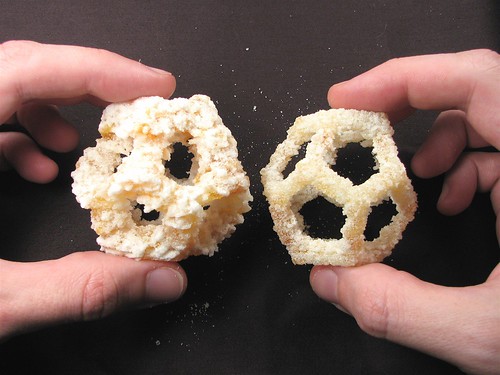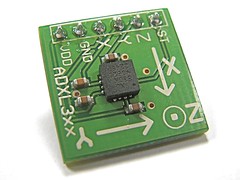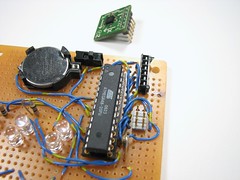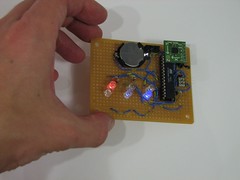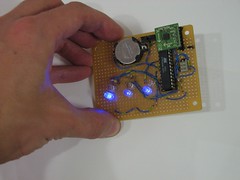I knew I couldn’t have been the first to make a QuiltBert, but I just couldn’t find any evidence for one online. That’s probably because in 1984 putting pictures of all your crafts online wasn’t yet commonplace, and that’s when Eric’s extremely cool mom made him this Q*bert quilt for naptime, making him the luckiest preschooler ever. It even has a brown plaid flannel border like mine! More pictures here, including a close-up where you can see some of the embroidery that went into making Coily. Many thanks for sharing it with us!
Candyfab: Now with higher resolution and edible output
Inside the PayPass: Credit card case mods
The PayPass is an RFID version of the MasterCard credit card. It is often available as a keychain “fob,” like the one shown above.
This particular one is from Citibank and is– as far as I can tell– a free optional addition to any Citibank Mastercard account. These have been in the wild for about a year now, and seem pretty handy. The obvious downside is that the RFID readers are far from ubiquitous. Still, things are improving and there are now quite literally dozens of places where you can use them.
From a hardware perspective it’s easy to see that this fob consists of the RFID element itself encased in a big block of plastic. And of course, plastic can be removed.
What it is
It’s time to reveal the mystery tool!
Wow– we’ve had some great answers– and some great restraint from those of you who already recognize it.
Thanks to everyone who participated!
Here are some of the guesses that were entered as comments– it’s a great list, and worth a read. My real surprise on this list: four guesses were that it was a piece of a time machine.
- Scoop for lifting boiled eggs out of water. (X5)
- Time Machine or part thereof (X4– WTF?)
- Golf ball retriever (X3)
- Eggcup (X2)
- Egg dipper for coloring Easter eggs (X2)
- Yolk separator (X3 — might work; kinda sharp.)
- Candle Snuffer (X2 — probably won’t work.)
- Antenna for communicating with intelligent aliens. (X2)
- A spiral (Yup.)
- Cocktail stirrer or Cocktail whisk
- Mayo whip
- Egg Beater
- Frothing whip for an espresso set.
- Heat sink for pouring hot water into glass (Does such exist?)
- Potato Masher
- Futon tataki, for beating the dust out of futons
- Magic wand for putting the magic smoke back into blown components! (Nice!)
- Magic wand – other (X2)
- Eggpoacher
- Hair ornament
- Implement to politely push away public huggers
- Ectoplasm handler
- Sproingy Springtime hamsterlift
- Barbeque tool
- Rejected design for a supppository.
- Manufacturing tool to keep two materials separate.
- An “Infinite Speculum.”
- “I’m not at liberty to say.”
- Golden Ratio Bubble Wand! (Neat idea!)
- Instrument used to keep eyes open whilst driving. (Ow!)
- Fancy urethral sound
- A bismuth crystal scoop.
- IUD
- Cone stand from an ice cream shop.
- Thalidomide baby contact-lens application tool. (High points for originality.)
- High quality nose picker.
To this list let me add my own “guesses”:
- Professional level egg-in-spoon-race spoon.
- Lollipop for robots.
- Support armature for world’s largest lollipop.
- Advanced nose-hanging spoon.
- Dieter’s ice cream scoop.
- Traditional umbrella for use during Festivus.
The tool is so simply and beautifully constructed that it is very difficult to judge the overall scale of the object. Is it three inches or three feet long? Of course, it turns out to be pretty small.
Nine answers assumed that the tool was the right size to hold an egg. And it sure is– a robin egg. ;)
You could indeed balance a chicken egg in the spiral, but it would be unsteady. The most popular answer was a tool for lifting boiled eggs out of water. Even for robin eggs, that would be difficult because (1) there’s very little angle between the spiral and the handle, and (2) the handle is very short. It might work as a golf ball retriever if the water trap is no deeper than your Beta bowl and you don’t mind turning the bowl upside down to get the ball out.
Honorable Mentions: The tool would be very good as a…
- Tea bag remover thingy
- Olive spoon for getting olives out of jars.
But of course, as one person answered, it’s a tool…
What is it?
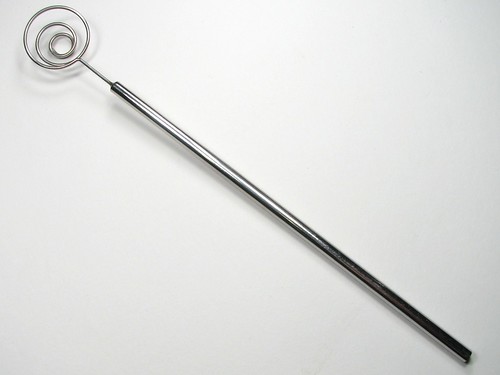
What is this mystery tool? Leave your guesses in the comments!
This particular item is one of my personal favorite tools. (We’re not the experts at this game, but we do like to play.)
P.S.: If you do instantly know what this is, please save your spoilers and let’s hear the guesses instead, m’kay?
Matt’s awesome chip desk

What does one do 434 discarded Itanium CPUs? Matt Tovey was inspired by our Chip Trivet, and used them to make this awesome computer desk.


The CPU modules were scrapped as the result of a supercomputer upgrade, and were presumably functional before having their heat sinks taken off– a herculean effort for that many CPUs! Matt says that the list price for the lot of chips was over US$800,000 in 2006 and that the desk contains about 2.8 TFLOPs of computing power, about the same
as 900 3.2GHz P4s.
Matt started with a plain desk, tiled in the CPUs, and added wooden edging and a beveled glass top. Nice work!
I just love the way that this desk looks. But it gives me an idea too– take it one step further, and what if it worked? You could use a single, giant PCB for the motherboard which sat underneath the glass surface of the desk. With that much area, you could fit in a lot of processing power. On the cheap (or moderately cheap), one could imagine instead filling the inside of a desk top with low-cost (even last-generation) PC motherboards to make a great looking beowulf cluster or render farm that doesn’t take up any desktop or rack-mount space.
Sadly, Matt’s page has moved on to the great /dev/null in the sky, but the mirror still shows some of the build photos.
Using an ADXL330 accelerometer with an AVR microcontroller
The last decade has seen more than an order of magnitude drop in the price of
accelerometers, devices capable of measuring physical acceleration (often in more than one direction). History suggests that whenever a useful technology makes a precipitous drop in price, unexpected applications follow, and that’s exactly what has happened in this case.
Starting from zero and summing up acceleration, you can use an accelerometer to find velocity, and from that derive relative position information. By measuring the acceleration due to gravity, one can also determine orientation (technically, inclination)– you can tell which way it’s pointing. Those are pretty useful skills for a chip! And so as bulk prices for tiny chip-scale three-axis accelerometers have begun to approach $5, they have started to appear in all kinds of mass-market applications that you might not have predicted: laptop computers (for hard drive protection), smart phones and cameras (for orientation– e.g., portrait vs. landscape on the iPhone), cameras for image stabilization, and quite visibly in the controllers for Nintendo’s Wii system.
With all that promise, you might think that an accelerometer is a difficult beast to harness. That turns out not to be the case. In this little project we demystify the mighty accelerometer and show you how to get started playing with one. In the spirit of hobbyist electronics we do this the easy way– without designing a PCB or even soldering any surface-mount components.
Note: An updated version of this article is now available here.
Continue reading Using an ADXL330 accelerometer with an AVR microcontroller
Book Review (and build!): Forbidden Lego
It was on the 12th of March this year that I first heard about, and placed my order for, Forbidden Lego, a new book by Ulrik Pilegaard and Mike Dooley, $24.95 from No Starch Press. It’s finally here, and yes, you want a copy.
Forbidden Lego was written by a pair of Lego master builders, who used to work in designing advanced Lego sets (e.g., Mindstorms). While they obviously got to work on lots of cool things while they were there, there were certain projects that just turned out not to be suitable to be made into kits released by the Lego company. They wrote the book to give some kind of a tantalizing hint at the kinds of things that go on behind the scenes at Lego, and the kinds of neat things that might get released in a world without product liability suits.
Continue reading Book Review (and build!): Forbidden Lego
How to Eat Fewer Insects (formerly on Instructables)
Supposing that you’re less than omnivorous, you may not always be in the mood to eat insects. You might be vegetarian, or your religion tells you that you shouldn’t eat insects, or maybe you’re just on a strict non-bug-eating diet. Here are a couple of simple hints to help you identify foods that contain bugs, illustrated with a few common supermarket candy items.
(Note: This article has been moved here from Instructables, where it was previously published. It has also been slightly updated.)
Continue reading How to Eat Fewer Insects (formerly on Instructables)
Sandra’s Camera Cozy
Sandra (flickr user lilysecret42) made a camera cozy based on our pattern. She added fleece padding and a velcro closure to make it just right for her. Awesome job! Thanks for putting it in the photo group so we could see it.





